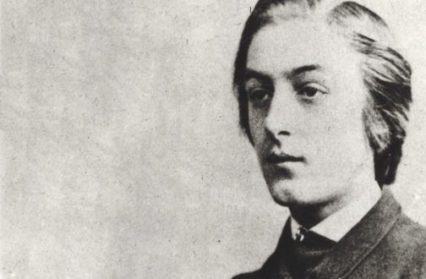John Idris Jones recalls the influence of an epochal poetry anthology.
I have a favourite book, an anthology of poetry called Modern Poetry. It was published by Prentice-Hall in the US, firstly in 1950; my edition (the second) is the twelfth printing, of 1962. It is edited by Mack, Dean and Frost, American academics. It has been widely used across American campuses, so it must be somewhat ‘authoritative’. My copy has the following annotation, “April 25, 1965 A “Waste Land” for Idris” At that time I was a graduate student at Cornell University, New York (state). I regret that I do not recall the person who gave me this book. But the inscription has resonance for me, personally, biographically and intellectually.
This anthology has 384 pages. It starts with a special section featuring five poets, so we can assume that the editors considered these to have special significance. They are: Hopkins; Yeats; Frost; Eliot and Auden. Hopkins is allocated twenty-three pages; Yeats forty-eight; Frost twenty-five; Eliot forty-five; Auden eighty-six. Yeats was born in 1865; Frost in 1874; Eliot in 1888 and – here’s the surprise – Hopkins in 1844. So Hopkins is easily the oldest, and when we see that the bulk of his verse-writing was done in the 1880s, and he died in 1889, and we compare this with Eliot, whose main work ‘The Waste Land’ is dated 1922, we realise that he chronology of ‘modern poetry’ in this collection belies the contention that modern poetry is poetry written after, say, 1913.
So, if the date argument is weak, how can we understand ‘modern poetry’? What does it mean? How do we use the term? Poetry which is not traditional, perhaps: this has conventional stanza-forms and patterned rhyming. We can say that verse libre characterises modern poetry: there’s even a name for the movement of meaning from one line to the next – enjambment. We can assert that traditional poetry has a regularity structure in rhyme and stanza-form; and ‘free verse’ has not. So much for structure: what about diction? It is often said that the more recent verse has the sound of natural speech. Wordsworth said he wanted to use “the language really used by men.” Whitman, in mid-nineteenth century, laid down a style which looks and sounds like common speech (American). Modern poetry has greater freedom on the page, avoiding archaic words, embracing the natural. Edward Thomas was a master at this; and D.H. Lawrence penned poems which read like pieces of speech. His ‘Snake’ is dated 1923. However, how do you turn broken-up prose in to good poetry?
Hopkins wrote a letter to R.W. Dixon in 1878 in which he said, with reference to ‘The Wreck of the Deutschland’: “I had long been hunting my ear the echo of a new rhythm which I now realised on paper.” This points to something new, but his poem has a rigid (say non-modern) line and rhyme structure. The poem’s thirty-five stanzas have eight lines rhyming ABABCBCA. So much for enjambment! We have here, essentially, two quatrains making an octave; very traditional. Inside this structure there is writing of extraordinary energy. It is as if spoken by a person in a state of passionate intensity (to borrow Yeats’s words). Religion, belief, commitment, debate and so on come through in each line in a way which had never been done before in verse. There is a certain looseness, almost carelessness about the diction; it is as if spoken by a person in a religious trance. The diction, to borrow Dylan Thomas’s remark, has “..language with blood pressure.” The new rhythm which Hopkins espoused is the rhythm of speech suffused with conviction and belief. ‘Tone’ communicates. We can expand on this and assert that in successful modern poetry, the writer has to inhabit his lines with his personality, vision, concentration, focus and conviction; and he has to express them in language which is understandable to the common person.
Two other poems by Hopkins call for examination, ‘The Windhover’ and ‘Pied Beauty’. Both are located in the fresh air: they are depictions of what is seen in the landscape. Take these lines from the former:
High there, how he rung upon the reign of a wimpling wing
In his ecstasy! Then off, off forth on swing
As a skate’s heel sweeps smooth on a bow-bend: the hurl and gliding
Rebuff the big wind
These words do not merely describe, they enact. The diction and rhythm replicate the actions of the falcon. The poet re-creates in words what he sees with his eyes. It is a kind of mimicry. Mimesis pertains. The tone and style of the poem is an image of the subject-matter, which is what is observed in sight.
In ‘Pied Beauty’ we have –
Landscape plotted and pieced – fold, fallow and plough;
And all trades, their gear and tackle and trim.
This is a portrait of the Vale of Clwyd from Tremeirchion. The method is unmistakable; the visible represented in words and sound. Again, we see representation, the subject-matter echoed in the lines of the poet.
As Archibald MacNeish wrote, with superb cogency: “A poem should not mean but be.” The quality of mimesis is implied here.
We are now closer to understanding why Hopkins is considered a ‘modern poet’. His work incorporates the qualities cited above.
In his New Bearings in English Poetry, F.R. Leavis dedicated thirty-three pages to the poetry of Gerard Manley Hopkins. He ends with: “He is likely to prove, for our time and the future, the only influential poet of the Victorian time, and it seems to me the greatest.












